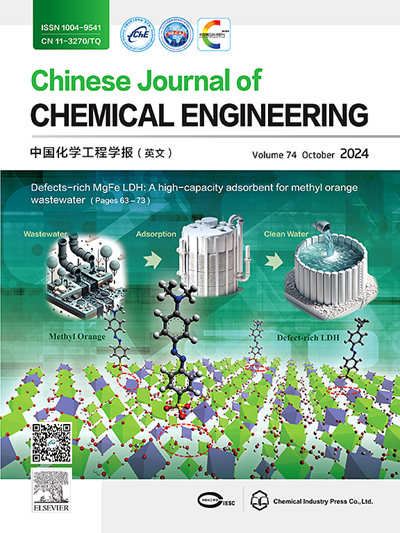CFD investigation in the temperature effect on coal catalytic hydrogasification in the pressurized bubbling fluidized bed
IF 3.7
3区 工程技术
Q2 ENGINEERING, CHEMICAL
引用次数: 0
Abstract
Temperature is a critical factor influencing the performance of coal catalytic hydrogasification in bubbling fluidized bed gasifiers. Numerical simulations at various temperatures (1023 K, 1073 K, 1123 K, and 1173 K) are conducted to elucidate the mechanisms by which temperature affects bubble size, global reaction performance, and particle-scale reactivity. The simulation results indicate that bubble size increases at elevated temperatures, while H₂-char hydrogasification reactivity is enhanced. Particle trajectory analyses reveal that particles sized between 100 and 250 μm undergo intense char hydrogasification in the dense phase, contributing to the formation of hot spots. To assess the impact of temperature on the particle-scale flow-transfer-reaction process, the dimensionless quantities of Reynolds, Nusselt, and Sherwood numbers, along with the solids dispersion coefficient, are calculated. It is found that higher temperatures inhibit bubble-induced mass and heat transfer. In general, 3 MPa, 1123 K, and 3–4 fluidization numbers are identified as the optimal conditions for particles ranging from 0 to 350 μm. These findings provide valuable insights into the inherent interactions between temperature and gas-particle reaction.

加压鼓泡流化床煤催化加氢气化温度效应的CFD研究
温度是影响鼓泡流化床煤催化加氢气化性能的关键因素。在不同温度(1023 K, 1073 K, 1123 K和1173 K)下进行了数值模拟,以阐明温度影响气泡大小,整体反应性能和颗粒级反应性的机制。模拟结果表明,随着温度的升高,气泡尺寸增大,h2炭加氢气化反应性增强。颗粒轨迹分析表明,粒径在100 ~ 250 μm之间的颗粒在致密相中发生了强烈的炭加氢气化,促进了热点的形成。为了评估温度对颗粒级流动-传递-反应过程的影响,计算了Reynolds、Nusselt和Sherwood数的无因次量以及固体分散系数。发现较高的温度抑制气泡诱导的质量和传热。一般情况下,3 MPa、1123 K、3 - 4个流化数是0 ~ 350 μm颗粒的最佳流化条件。这些发现为了解温度与气粒反应之间的内在相互作用提供了有价值的见解。
本文章由计算机程序翻译,如有差异,请以英文原文为准。
求助全文
约1分钟内获得全文
求助全文
来源期刊

Chinese Journal of Chemical Engineering
工程技术-工程:化工
CiteScore
6.60
自引率
5.30%
发文量
4309
审稿时长
31 days
期刊介绍:
The Chinese Journal of Chemical Engineering (Monthly, started in 1982) is the official journal of the Chemical Industry and Engineering Society of China and published by the Chemical Industry Press Co. Ltd. The aim of the journal is to develop the international exchange of scientific and technical information in the field of chemical engineering. It publishes original research papers that cover the major advancements and achievements in chemical engineering in China as well as some articles from overseas contributors.
The topics of journal include chemical engineering, chemical technology, biochemical engineering, energy and environmental engineering and other relevant fields. Papers are published on the basis of their relevance to theoretical research, practical application or potential uses in the industry as Research Papers, Communications, Reviews and Perspectives. Prominent domestic and overseas chemical experts and scholars have been invited to form an International Advisory Board and the Editorial Committee. It enjoys recognition among Chinese academia and industry as a reliable source of information of what is going on in chemical engineering research, both domestic and abroad.
 求助内容:
求助内容: 应助结果提醒方式:
应助结果提醒方式:


